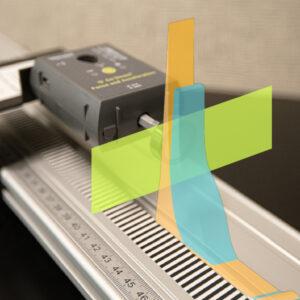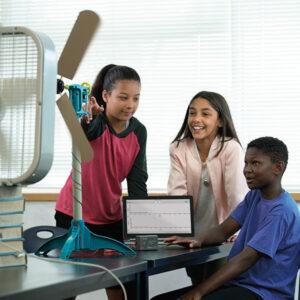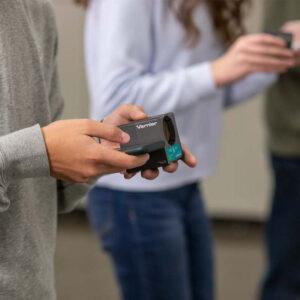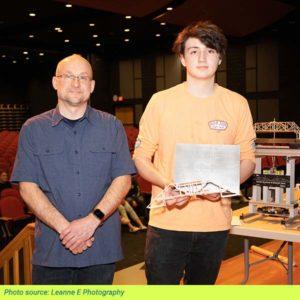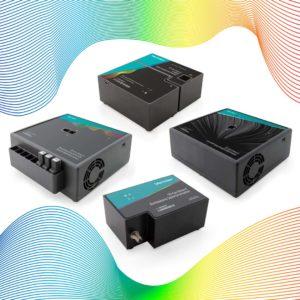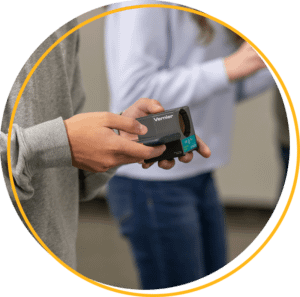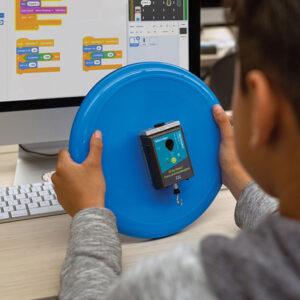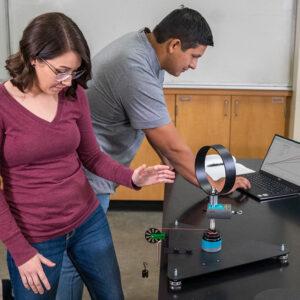
Sharing ideas and inspiration for engagement, inclusion, and excellence in STEM
3 Hands-On Experiments Using the Go Direct Force and Acceleration Sensor
From everyday activities like opening a door or riding a bike to more complex applications like designing safer cars or propelling rockets into space, force impacts countless aspects of our daily lives. Yet, for many students, force remains an abstract concept—there is nothing for them to “see” or “touch.”
Real-World Physics Problems: Using Vernier Video Analysis to Build Evidence for Safer School Zones
Every day, my students cross 112th Street outside our high school—a busy, four-lane corridor with a 40 mph speed limit that often feels more like 50. When I asked my class how they feel when they walk home or cross that road, most of them had similar answers.
Spooky Science: Five Hands-On Experiments with a Halloween Spin
Halloween is the perfect opportunity to make science a little more engaging—and a lot more memorable. With just a touch of creative framing, you can add a spooky, seasonal twist to these Vernier experiments across chemistry, biology, or physics.
From exploring the glow in glowsticks to tracking heart rates during a scare, these hands-on ideas use Go Direct® sensors and Vernier Graphical Analysis® to help students explore core science concepts through a new (and slightly eerie) lens.Roller Coaster Physics: Engaging Students with Real‑World Amusement Park Data
For many students, an amusement park trip is more than just a reward at the end of a school year—it can be the real-world experience that actually makes applied physics click. As Vernier physics and engineering specialist Josh Ence recently shared during our roller coaster physics webinar, he once had students sign up for AP Physics simply because they knew the class would end with a roller coaster field trip.
When paired with Vernier technology, an amusement park becomes a full‑scale laboratory. The Go Direct® Acceleration Sensor, Vernier Graphical Analysis® Pro, and Vernier Video Analysis® help teachers transform adrenaline‑pumping loops, drops, and swings into NGSS-aligned investigations that make core physics concepts real and memorable.3 Hands-On Experiments for Teaching Torque and Moment of Inertia
When I was teaching AP Physics C, I assumed rotational motion would be easy for my students. These were strong math and science learners—most of them were already in calculus. So I used to introduce rotational motion by saying, “You already know this! It’s just linear motion, but with Greek letters.”
An Egg Drop Alternative: A Force to Reckon With
Last spring break, I came back to school ready to run my usual momentum lab, the classic egg drop, only to be met with an unexpected obstacle: egg prices. Breaking 80–100+ eggs over 5 class periods was going to be far too expensive.
So I decided to try something different. I set out to design a new laboratory activity to close out our momentum chapter that would convey the same engineering principles, without requiring hundreds of eggs. What started as a budget-friendly replacement turned into a richer, more mathematically robust activity that uses Vernier probeware for real-time quantitative analysis and keeps students highly engaged through friendly competition baked into the lesson. Even if egg prices do go back to normal, this is the lab I’m sticking with.3 Hands-On, Low-Prep Sensor Activities to Start the School Year
The first week of school is a great time to lean into student curiosity, help everyone get comfortable with your lab routines and tools, and build students’ confidence with Vernier sensors and software. Whether you teach middle school science, high school science, or introductory college courses, the goal is the same: Empower students to use real-time data to make sense of the world.
Stories That Stick: Ideas for Integrating Science and Language Arts
Whether it’s through science fiction novels, engaging literary nonfiction, or comics, educators are finding creative ways to bring literacy into STEM learning. These approaches echo the research‑backed connections between Common Core literacy standards and the NGSS Science and Engineering Practices, particularly in the areas of argumentation, communication, and evidence‑based reasoning.
Four 3D-Aligned Experiments for Your Middle School Classroom
Middle school is a great time to give students more experience collecting and working with data. Whether they’re testing chemical reactions, tracking environmental changes, or exploring energy systems, hands-on investigations help them connect big science ideas to the world around them.
From Seafloors to Salinity: 3 Hands-On Investigations into Ocean Science Phenomena
Covering more than 70% of Earth’s surface, the ocean plays a vital role in our planet’s climate, ecosystems, and everyday life. World Ocean Day (June 8) and World Ocean Month offer timely opportunities to explore this dynamic system through interdisciplinary learning that connects chemistry, biology, Earth science.
5 Key Tools in Vernier Video Analysis—And How to Use Them
Vernier Video Analysis® helps students explore motion through real-world video, giving them a hands-on way to connect graphical representations of data with the movement they actually see. Whether you're just getting started or looking for a refresher, this post walks you through five key tools in the app—along with tips on when and why to use each one.
Animal Acoustics: Analyzing Sound Waves in Physics and Biology
How can physics principles help us better understand biological phenomena? Sound provides a perfect opportunity to bridge these disciplines. By analyzing biological sound patterns—such as whale songs, bird calls, or bat echolocation—students can explore the physics of waves while gaining insights into animal communication and behavior.
In physics, sound is typically studied in units on waves and vibrations, where students examine properties like frequency, amplitude, and wave interference. These same principles also play a role in biology, where sound is crucial for animal behavior, communication, and survival. Using tools like the Go Direct® Sound Sensor and Go Direct Motion Detector, educators can help students connect wave properties to real-world biological systems and take a cross-cutting approach that emphasizes structure and function in both subjects.From the Sky to the Sea: Exploring Earth’s Magnetic Field and Its Impact on Real-World Phenomena
Have you noticed an uptick in the number of opportunities to see aurora borealis—also known as the northern lights—in the last year? While these light displays are common in polar regions such as the Arctic, they have been more visible across a number of states as of late. The reason? A surge in solar activity that directly interacts with Earth's magnetic field.
Force and Motion: Creating Two Classic Physics Questions in Real Life with Vernier Cart Fans
There are two questions that can really give some insight into complicated physics concepts. However, I want to do more than just ask the questions. I want to SHOW these situations using the Vernier Cart Fans.
Everything You Need to Know About the Logger Pro Transition
For more than 20 years, Logger Pro™ has been a trusted tool for educators helping students explore real-world data in real time. To our long-time Logger Pro users, thank you for making this application a cornerstone of your classrooms. We’re proud of its legacy and excited to share this next chapter of data analysis with you.
Our Top Blog Posts of 2024
Wow, 2024 has been an unforgettable year! From launching our inaugural Vernier Trendsetters Community cohort and witnessing a total solar eclipse alongside educators across the path of totality, to welcoming Jill Hedrick as our new CEO, we’ve celebrated many milestones. This year also saw the release of exciting new tools, including the Cart Fan, Go Direct® Force Plate, Go Direct Salinity Sensor, and Go Direct Soil Moisture Sensor!
Three Light and Wave Physics Investigations with the Go Direct Light and Color Sensor
Ever wonder why car headlights look dim from a distance but shine bright up close? Or how your sunglasses can block out glaring light? These are just a few of the real-world phenomena your students can explore with the Go Direct® Light and Color Sensor. Combining multiple sensors to measure light intensity across the visible and ultraviolet parts of the electromagnetic spectrum, this versatile tool can be used in a wide range of science applications. We’re highlighting three hands-on experiments that invite students to investigate real-world phenomena and explore the physics behind light and waves.
Three Mechanics Investigations with the Go Direct Motion Detector
There are many ways to measure motion in your physics classes, from the classic meter stick and stopwatch method to photogates and sensor carts. But the Go Direct® Motion Detector is one of the most versatile, engaging tools you can leverage in your classroom. This sensor measures the position of moving objects by sending out an ultrasonic pulse (a sound wave at a frequency beyond human hearing) and using the echo from its target to calculate velocity and acceleration data.
Studying Conservation of Angular Momentum with Vernier Video Analysis
British mathematician Roger Penrose once stated, “Sometimes it’s the detours which turn out to be the fruitful ideas.” I am always searching for innovative ways to connect what students are learning in my physics class with the real world.
In late April, during a visit to the Staten Island Target®, a family member yanked my arm so we could “see what cool stuff they had in Bullseye’s Playground,” the area of seasonal products right by the entrance. Amongst the plastic pitchers and 4th of July decor, I spotted the Target plastic Water & Sand Mill, priced at just $1.Where Math Meets Science: Connecting Vernier Go Direct Sensors and TI-Nspire Technology
Looking for ways to make math more accessible to your students? Help them build confidence in math and science concepts by using real-time data collection! When students are tasked with exploring real-world phenomena, math transforms from an abstract, intimidating concept into a practical tool that students can use to develop and articulate answers to questions like, “Why are headlights on a car dimmer at a distance?” or “Why do I feel warmer wearing a black shirt on a sunny day?”
With enhanced compatibility between Vernier and Texas Instruments, students can now explore math in tangible, real-world scenarios by wirelessly capturing and analyzing real-time data on their TI-Nspire™ CX II graphing calculators. By integrating math and science, educators can enrich student comprehension, deepen their understanding of the natural world, and prepare students for careers in STEM.How to Introduce Your Students to Data-Collection Basics
Whether studying CO2 changes during photosynthesis or investigating the conservation of momentum during a collision, students need to be able to do more than just plot points on a graph—they need to understand the story that a graph tells. One incredibly effective way to develop this kind of data literacy is to incorporate data-collection technology and investigations into your instruction. Real-time data collection not only helps students build stronger connections between abstract scientific concepts and the real world but also helps students transform raw data into meaningful insights through tabulation, graphs, visualization, and statistical analysis.
Three Ready-to-Use 3D Physics Investigations to Maximize Impact with Vernier Sensors
“What’s going on here?” our principal asks, eyebrows raised, as a foam baby in a car seat attached to a dolly races down a ramp, straight into a brick wall.
Five Trailblazing Female Asian American & Pacific Islander Scientists with Impactful STEM Legacies
May is National Asian American and Pacific Islander Heritage Month, an excellent time to help your students learn about the pivotal contributions Asian Americans, Native Hawaiians, and Pacific Islanders have made to the STEM fields—and continue to make today! As we celebrate their accomplishments, it’s also important to acknowledge the gaps in visibility within these groups, particularly among AAPI women in science. For example, recent studies have shown women in this demographic are notably less likely to be employed in leadership positions in STEM, even when highly educated. This discrepancy also persists in educational resources, where textbooks continue to underrepresent women and people of color in STEM. To help spotlight their considerable academic and scientific research contributions, here are five influential AAPI women whose stories and achievements you can share with your students, as well as a few experiment ideas to connect with their research.
Ready, Set, Science! Get Your Science Game On with These Four Sports‑Themed Experiments
We had such a blast at NSTA Denver 2024 last week! One of our big highlights this year was getting to mix science and sports with fun, athletics-inspired activities. Below we’re sharing four of our favorite sports-themed experiments you can try out to elevate your classroom game!
Exploring the Antarctic with Vernier: A Physics Teacher's Expedition to Inspire Classroom Science
The Grosvenor Teacher Fellowship (GTF) is an experiential professional development opportunity offered through the National Geographic Society and Lindblad Expeditions. This program sends teachers out on expeditions to remote locations to inspire them to inspire their students.
Two Hands-On Motion Investigations with the New Go Direct® Force Plate
Engaging students in physics can be as simple as getting them moving! The Go Direct® Force Plate, our newest physics sensor, invites students to explore the principles of motion through their own actions like jumping, stepping, and pushing. Equipped with wireless capabilities and brand new channels including Hang Time for physics classes, and Jump Height and X- and Y-axis Balance for physiology classes, the Force Plate opens up new avenues for creativity and exploration in the classroom. In this blog post, we are sharing two investigations we recommend to help explore physics fundamentals using the Go Direct Force Plate.
Empowering Students through Career-Based Learning and STEM Representation in Physics and Engineering Classrooms
Anticipating a projected 10.8% growth in STEM occupations over the next decade, the STEM Academy of Hollywood, a pilot high school in Hollywood, California, emphasizes career-focused education. The school centers on two career pathways: Engineering and Biomedical Science, utilizing curriculum from Project Lead the Way. Regine Rosas, who comes from a biomedical engineering background, teaches physics and electives in the engineering pathway to help students prepare for the evolving STEM landscape.
Five Tips for Optimizing Data Collection with Photogates
Photogates, at first glance, are one of our simplest sensors. They can capture incredibly precise snapshots of an object’s motion data utilizing just two LEDs. But despite their relative simplicity, photogates are actually incredibly versatile. They can detect objects in a range of sizes, from a marble to a pickup truck. And with just a brief snapshot, they can measure anything from the swing of a pendulum to the acceleration of a cart on a ramp to the speed of a collision—with the right alignment and precision. Here are five tips to help you get the most out of your experiments using photogates.
Choosing the Right Cart and Track System for Your Physics Classroom
The Dynamics Cart and Track System is at the core of every physics lab. These versatile setups equip students with the tools they need to explore fundamentals in kinematics, dynamics, momentum, and energy.
Smashing Squash and Regurgitating Gourds: Eerie Experiments for Your Physics and Chemistry Classes
As we officially move into autumn and begin creeping closer to the spookiest season of the year, it’s the perfect time to add a little bit of pumpkin spice to your science curriculum.
Empowering Student-Led Discovery in the Physics Classroom: A Conversation with Texas Educator Michelle Jedlicka
Michelle Jedlicka, a veteran teacher at A&M Consolidated High School in Texas, has a packed schedule this fall with four physics classes on her roster: AP Physics 1, AP Physics C, Independent Research, and Integrated Physics and Chemistry. Despite the varying levels of her students, she finds the same principle underpins them all—hands-on experience is crucial to student learning.
Exploring Magnetic Fields: Three Hands-On Experiments with the Go Direct 3-Axis Magnetic Field Sensor
Looking for fresh ways to engage your students in the study of magnetic fields? Guide your students through the invisible forces that influence our world with the Go Direct 3-Axis Magnetic Field Sensor.
Back-to-School Experiments to Kick-Start Your School Year
As we gear up to welcome students back to the classroom, it’s the perfect time to strategically introduce (or reintroduce) the fundamental principles of data collection. No matter the subject, understanding how to collect, analyze, and interpret data is not only key to fostering good inquiry, it’s also a fun way to spark engagement in students as they come back to class from summer break.
We’re sharing our favorite back-to-school science experiments that use some of our most popular sensors, including the Go Direct® Temperature Probe, the Go Direct Conductivity Probe, and the Go Direct Motion Detector. Give these a try to get your students moving, mixing, measuring, and observing in the classroom this fall!Three Tips to Help You Get the Most Out of the Go Direct Motion Detector
One of the most versatile ways for students to measure motion—a key scientific concept—is the
Go Direct® Motion Detector.Three Experiments that Highlight How Vernier Graphical Analysis® Pro Can Elevate Physics Learning
Energy, acceleration, and simple harmonic motion are just a few important physics principles for students to learn—and using the Graphical Analysis Pro app with our Go Direct® sensors can help bring these abstract scientific concepts to life.
Meeting the Needs of All Learners in Every Vernier Connections™ Lesson
At Vernier, our goal is to help all students become STEM-literate citizens. So, as we develop lessons for Vernier Connections, it is critical that we design a journey that will support the learning of all students.
Three Experiments for Exploring Physics with the Go Direct® Force and Acceleration Sensor
Understanding key physics concepts, such as Newton’s laws of motion, gives students a solid foundation for exploring real-world physics applications—and the Go Direct Force and Acceleration Sensor is a great tool for laying that groundwork and building on it.
How to Choose the Right Spectrometer for You
Spectrometers are a great tool for helping your students explore important scientific concepts across a range of biology, chemistry, and physics courses—and Vernier offers a suite of spectrometers that are fast, compact, and easy to use.
Five Ways to Take Physics Learning on the Go with the Go Direct® Acceleration Sensor
With the right tools, your students can explore important physics concepts in the real world—even when they’re traveling.
Hands-On Physics Learning with Water Rockets, Mousetrap Race Cars, Bridges, and Wind Turbines
All students benefit when they can apply physics principles and concepts by building something. Having that real-world connection can help make physics easier to understand. As an added bonus, it can also increase student engagement.
Hands-On Teaching Strategies to Help Students Understand the Physics Behind Electricity and Sound
Let me begin with a confession: I majored in chemical engineering, not physics. In addition, when I was in college, calculus-based physics and electrical fundamentals courses were used to weed out would-be engineering majors.
Five Tips for Collecting High-Quality Video to Analyze in Vernier Video Analysis®
Motion is an important concept that can be challenging for students to comprehend. However, Vernier Video Analysis makes studying motion easy and accessible.
Unlock Scientific Innovation with These College Experiments
Vernier offers more than 1,000 experiments in biology, chemistry, engineering/robotics, and physics that can promote STEM literacy and help you integrate data-collection technology into your courses.
Elevate Hands-On STEM Learning with These K–12 Experiments
Vernier offers more than 1,000 experiments in biology, chemistry, engineering/robotics, and physics that can promote STEM literacy and help you integrate data-collection technology into your classes.
College Experiments of the Month: Unlock Scientific Innovation
Vernier offers more than 1,000 experiments in biology, chemistry, engineering/robotics, and physics that can promote STEM literacy and help you integrate data-collection technology into your courses.
K–12 Experiments of the Month: Elevate Hands-On STEM Learning
Vernier offers more than 1,000 experiments in biology, chemistry, engineering/robotics, and physics that can promote STEM literacy and help you integrate data-collection technology into your classes.
Getting Students Involved and Invested in Their Own Learning with User-Friendly Vernier Technology: A Q&A with Alexandra Boyd
Alexandra Boyd teaches AP Physics at Apex Friendship High School in Apex, North Carolina. Last year, she won a 40th anniversary educator grant from Vernier, which included $1,000 in Vernier technology. We sat down with Boyd to discuss the impact of the grant on her and her students. The interview has been edited for length and clarity.
Versatile Go Direct® Light and Color Sensor Helps Illuminate Concepts Across the Science Curriculum
Good things come in small packages—including the Go Direct Light and Color Sensor.
Using Stirling Engines and Vernier Technology for Hands-On Physics Investigations
Note: A version of this story was originally posted on the Vernier website in August 2021.
Five Research-Based Best Practices for STEM Education
The quest for high-quality STEM education starts with having a solid foundation grounded in research. But what exactly does the research say about high-quality STEM education?
College Experiments of the Month: Unlock Scientific Innovation
Vernier offers more than 1,000 experiments in biology, chemistry, engineering/robotics, and physics that can promote STEM literacy and help you integrate data-collection technology into your courses.
K–12 Experiments of the Month: Elevate Hands-On STEM Learning
Vernier offers more than 1,000 experiments in biology, chemistry, engineering/robotics, and physics that can promote STEM literacy and help you integrate data-collection technology into your classes.
Python® and LabQuest®: Opening Up Opportunities for STEM Educators and Students
When you think about ways to teach science, coding might not be the first thing that comes to mind.
Giving Students Hands-On Experience with the Engineering Design Process
What do you get when you take 40 to 60 high school students from across the northeast corner of the Keystone State, add a bunch of basswood, and throw in physics and engineering concepts?
Ramp Up Physics Learning Using Our Dynamics Cart and Track System with the Go Direct® Sensor Cart
Get all the equipment you need to teach dynamics and kinematics using our Dynamics Cart and Track System with the Go Direct Sensor Cart. This wireless system simplifies experiment setup and allows basic physics experiments to be conducted with or without the track.
K–12 Experiments of the Month: Elevate Hands-On STEM Learning
Vernier offers more than 1,000 experiments in biology, chemistry, engineering/robotics, and physics that can promote STEM literacy and help you integrate data-collection technology into your classes.
College Experiments of the Month: Unlock Scientific Innovation
Vernier offers more than 1,000 experiments in biology, chemistry, engineering/robotics, and physics that can promote STEM literacy and help you integrate data-collection technology into your courses.
College Experiments of the Month: Unlock Scientific Innovation
Vernier offers more than 1,000 experiments in biology, chemistry, engineering/robotics, and physics that can help you inspire students and integrate data-collection technology into your science courses.
All three of this month’s experiments were featured in or inspired by recent Vernier webinars. Our webinars are a great way to see our experienced educational technology specialists demonstrate Vernier experiments, answer your top questions, and provide tips about using our products to engage your students. Visit our website to check out webinar recordings and register for upcoming webinars.K–12 Experiments of the Month: Elevate Hands-On STEM Learning
Vernier offers more than 1,000 experiments in biology, chemistry, engineering/robotics, and physics that can help you inspire students and integrate data-collection technology into your STEM classes.
All three of this month’s experiments were featured in or inspired by recent Vernier webinars. Our webinars are a great way to see our experienced educational technology specialists demonstrate Vernier experiments, answer your top questions, and provide tips about using our products to engage your students. Visit our website to check out webinar recordings and register for upcoming webinars.STEM Education Innovation: Inspiring Physics Students Through Gaming
Note: A version of this story was originally posted on the Vernier website in August 2020.
College Experiments of the Month: Unlock Scientific Innovation
Vernier offers more than 1,000 experiments in biology, chemistry, engineering/robotics, and physics that can help you inspire students and integrate data-collection technology into your science courses.
All three of this month’s featured experiments involve our spectrometers. To further explore the use of spectrometers, check out our Illuminate Spectroscopy webinar.Spotlight on Our Go Direct® Spectrometers
Fast. Compact. Easy to use.
K–12 Experiments of the Month: Elevate Hands-On STEM Learning
Vernier offers more than 1,000 experiments in biology, chemistry, engineering/robotics, and physics that can help you inspire students and integrate data-collection technology into your STEM classes.
All three of this month’s featured experiments involve our spectrometers. To further explore the use of spectrometers, check out our Illuminate Spectroscopy webinar.Spark Scientific Curiosity with These Award-Winning Apps
To help educators reignite students’ love of learning science this spring, Vernier is providing
K–12 Experiments of the Month: Elevate Hands-On STEM Learning
Vernier offers more than 1,000 experiments in biology, chemistry, engineering/robotics, and physics that can help you inspire students and integrate data-collection technology into your STEM classes. We will be featuring at least one of our experiments in each edition of The Caliper.
College Experiments of the Month: Unlock Scientific Innovation
Vernier offers more than 1,000 experiments in biology, chemistry, engineering/robotics, and physics that can help you inspire students and integrate data-collection technology into your science courses. We will be featuring at least one of our experiments in each edition of The Caliper.
STEM Education Innovation: Using Water Rockets and Data-Collection Technology to Teach Physics
We’re always excited when educators share the ways they use Vernier products in their STEM classes—and we’re always so impressed by their ingenuity. We will be showcasing at least one example of STEM education innovation in each edition of The Caliper.
Celebrating Latinx Scientists and Their Work: Resources for Your Classroom
National Hispanic Heritage Month offers a great opportunity for students to learn about the many Latinx contributions to STEM.
Three Ways to Enliven Remote Learning with Vernier Graphical Analysis Pro
Since COVID-19 cases remain stubbornly high across the country, it’s clear that remote learning isn’t going away. And while this teaching concept isn’t new anymore, many STEM educators are still struggling to beat video conference fatigue and keep students engaged in the remote classroom. For science teachers who depend on hands-on experiments to demonstrate scientific concepts, remote learning presents a unique question: how do you remotely teach science in a way that holds students’ attention?
Vernier Video Analysis® Wins Industry-Leading Award
The Vernier Video Analysis app recently won a Tech & Learning Award of Excellence in the software category. The feature-rich app, which helps students learn key physics concepts and engage in video analysis in both in-person and remote learning environments, was recognized with this industry-leading award for its impact on student learning.
Bring Video Analysis to Your Students in a Dedicated and Streamlined Application
Vernier Video Analysis™, a new member of our family of apps, is available. Right now, you can get a free trial through June and take advantage of our special introductory pricing.
Introducing Kinematics Using Motion Detection and Real-Time Graph Matching
This is my 28th year teaching high school physics. The last 23 years I’ve been at Century High School, in Hillsboro, Oregon, and I’ve taught many levels of physics. An introductory course that I teach covers kinematics, dynamics, energy, momentum, wave fundamentals (including sound and light), and electricity. Through all of my classroom experience, I’ve found that introducing data-collection technology through hands-on experiments that tie into the real world is often the most effective way to help students understand key science concepts and keep them engaged in the classroom.
Infinite Investigations with Go Direct® Acceleration
Martin Horejsi of NSTA Recommends recently tested the Go Direct® Acceleration sensor and called it a “rock-solid piece of science instrumentation” with an “infinite number of uses.” In the article, “Measuring Murphy’s Law with the Vernier Go Direct Acceleration Sensor,” he describes the technology, and details the numerous hands-on investigations he conducted using the sensor.
One Device for Teaching Science and Coding with Scratch
Do you teach force and motion? Equipped with a load cell to measure force and both an accelerometer and gyroscope to measure motion, our Go Direct® Force and Acceleration Sensor is perfect for hands-on science activities. Drag a sneaker across the floor to study friction, or tie Go Direct® Force and Acceleration Sensor to a string and swing it around your head to investigate circular motion. Incorporate the sensor in your LEGO® machines and measure the mechanical advantage of levers and ramps.
Building a Better Mousetrap – A New Vernier Photogate
We are excited to announce a new sensor for physics—Go Direct Photogate. With our first-ever wireless photogate, you get better-than-stopwatch timing accuracy of a cart traveling eight or more meters without having to run wires between the gates. And that is not even its best feature.
Go Direct® Sound Featured on NSTA Recommends
Martin Horejsi, from NSTA Recommends, has collected data with Go Direct Sound just about everywhere on campus. In his review, “The Vernier Go Direct Sound Sensor: See Sounds in a New Light (Bluetooth),” Martin discusses the importance of sound safety, provides a brief history of the decibel, and details various investigations using Go Direct Sound.
The Centripetal Force Apparatus Goes Wireless
The new Go Direct® Centripetal Force Apparatus makes it easier than ever to investigate rotational dynamics. Students can investigate the relationships among force, mass, and radius wirelessly—all you need is the Go Direct Centripetal Force Apparatus, a Go Direct Force and Acceleration Sensor, and a device running our free Graphical Analysis™ 4 app. No additional interface is needed.
How to Collect Data from a Fidget Spinner and a Photogate
Like most people, I have heard the buzz about "fidget spinners", so I could not resist buying one and taking some data with it. Here is a graph of data collected using Logger Pro, LabQuest Mini, and a Photogate.
Quantifying Sources of Systematic Error in Video Analysis Experiments
Video analysis experiments have strong potential to reinforce student learning and build intuition; however, in the intro physics lab, students often find experimental values that are substantially different from the expected results (e.g., a curve-fit derived value for g of 11.59±0.02 m/s2 for a tossed golf ball). Despite giving students specific instructions for setting up video equipment, we frequently see poor experimental results. This suggests that small variations in the experimental setup produce significant systematic errors.

Sign up for our newsletter
Stay in the loop! Beyond Measure delivers monthly updates on the latest news, ideas, and STEM resources from Vernier.
Beyond Measure started as a printed, biannual newsletter in 1984. See the evolution of STEM education over 41 years.






